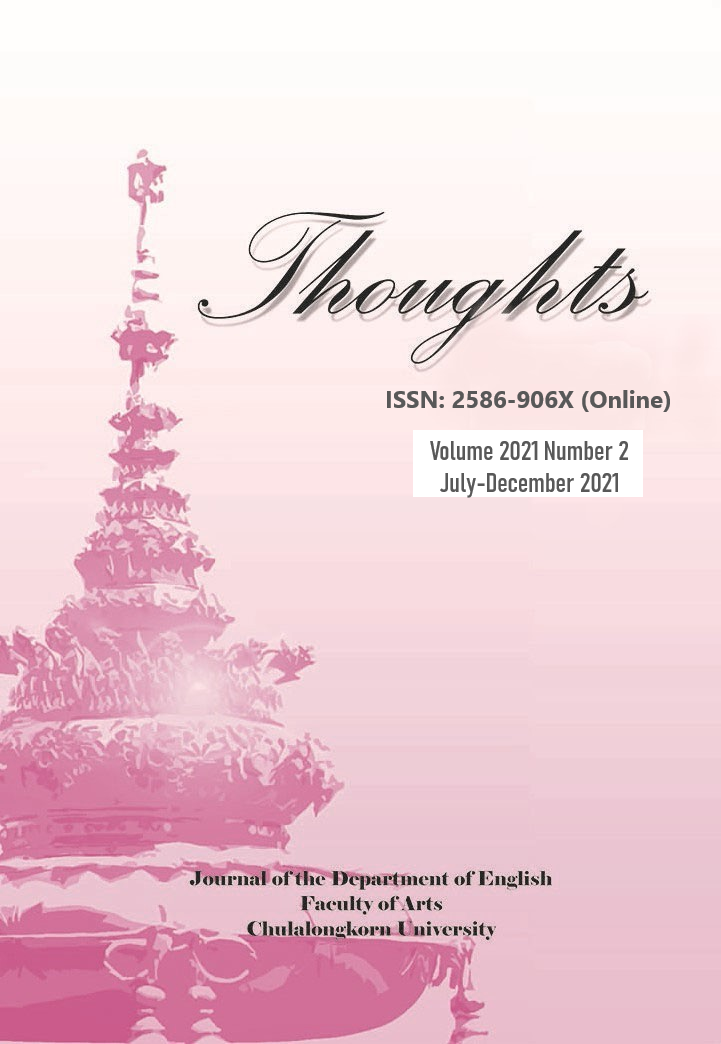“A Cake for which the Flour had been Forgotten”: The Escape from Queer Nonentity in Elizabeth Bowen's The Last September
DOI:
https://doi.org/10.58837/CHULA.THTS.2021.2.1Keywords:
nonentity, queerness, androgyny, maturation, The Last SeptemberAbstract
Building upon the popular notion that Lois’s growth in The Last September remains stunted, this paper posits that the young protagonist, who even wallows in a state of queer nonentity, does, in fact, grow up. Employing Virginia Woolf’s concept of the artist’s self-effacing androgynous mind, the paper traces how Lois’s androgynous qualities seem to keep her in a state of limbo, in which her identity is void or frozen, not unlike that of her Protestant Ascendancy class in 1920. However, both Lois’s political and sexual maturation, which culminates in the ruined mill scene at the end of the novel’s second section, is set in motion by the guidance of Marda Norton, who, also possessing androgynous characteristics, serves as Lois’s mirror figure but, embodying a more experienced and established identity, disapproves of Lois’s kind of void-inducing queerness. Although the end of the novel points to the notion that both Marda and the now-mature Lois still face the constant threat of being, again, stunted, their existence attests to the survival of the Ascendancy, albeit in a less complacent state, as Danielstown, the symbol of the Anglo-Irish Big House culture, is being burned down at the end.
References
Bowen, E. (2000). The last september. Anchor.
Brown, M. (2012). Strange associations: Elizabeth Bowen and the language of exclusion. Irish Studies Review, 20(1), 3-24.
Cammack, S. (2017). The death of a gramophone in Elizabeth Bowen’s The Last September. Journal of Modern Literature, 40(2), 132-146.
Corcoran, N. (2001). Discovery of a lack: History and ellipsis in Elizabeth Bowen’s The Last September. Irish University Review, 31(2), 315-333.
Cullingford, E. (2007). “Something else”: Gendering onliness in Elizabeth Bowen’s early fiction. MFS Modern Fiction Studies, 53(2), 276-305.
Esty, J. (2007). Virgins of empire: The Last September and the antidevelopment plot. MFS Modern Fiction Studies, 53(2), 257-275.
Esty, J. (2012). Unseasonable youth: Modernism, colonialism, and the fiction of development. Oxford UP.
Trehy, B. (2011). In ruin unreconciled: Women writers and the end of the British empire [Doctoral dissertation, Maynooth University, Ireland]. MURAL. https://mural.maynoothuniversity.ie/6996/
Williams, J. M. (1995). “Fiction with the texture of history”: Elizabeth Bowen’s The Last September. MFS Modern Fiction Studies, 41(2), 219-242.
Woolf, V. (1989). A room of one’s own. Harcourt.
Downloads
Published
Issue
Section
License
Copyright (c) 2021 Thoughts

This work is licensed under a Creative Commons Attribution-NonCommercial-NoDerivatives 4.0 International License.
Copyright by the Faculty of Arts, Chulalongkorn University.
Photocopying is allowed for internal, non-commercial use only. Photocopying for other uses or for purposes other than indicated must be permitted in writing from the Faculty of Arts, Chulalongkorn University.
All views or conclusion are those of the authors of the articles and not necessarily those of the publisher or the editorial staff.


